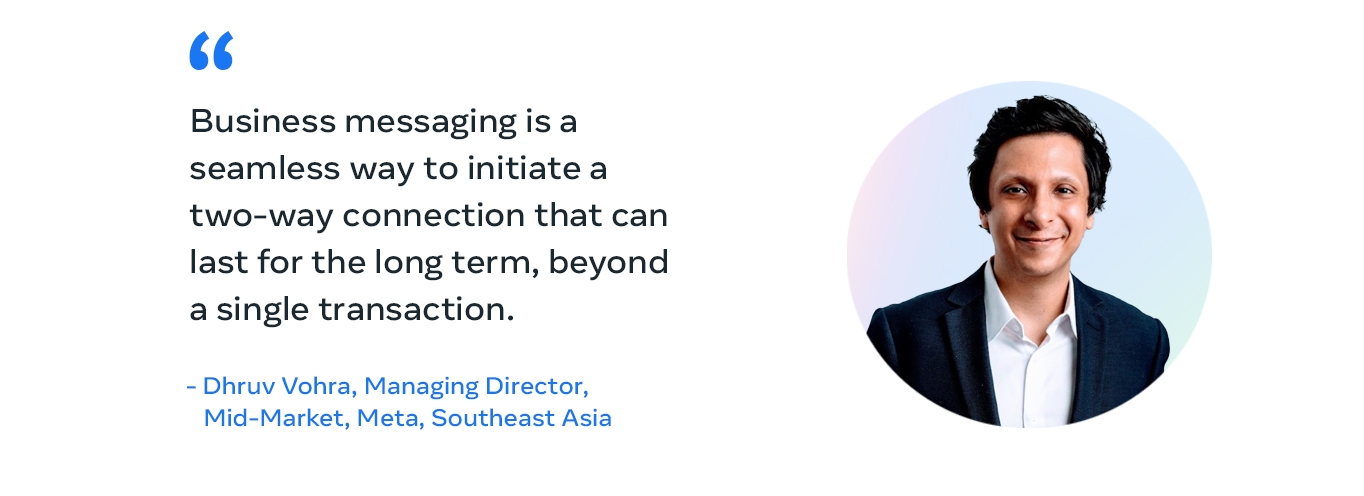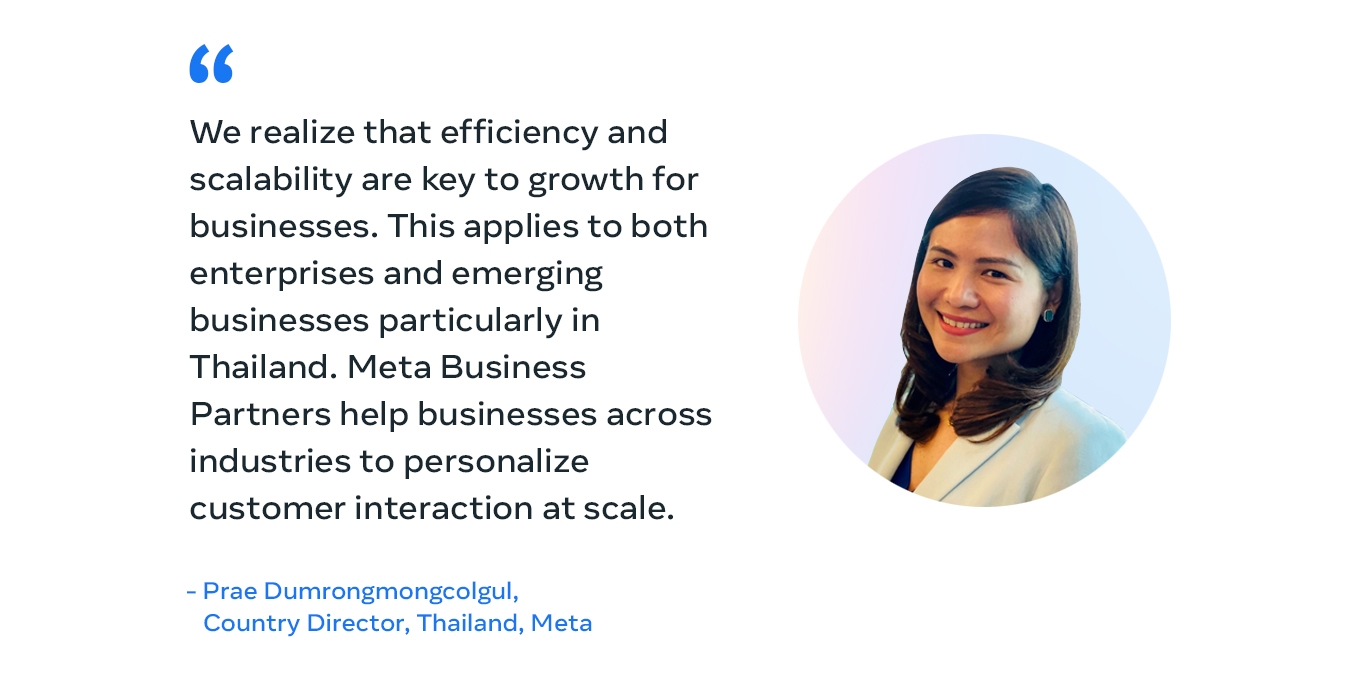The Quiet Channel Revolution Reshaping Customer Connections
People crave human connection. We’re hard-wired for it. As technology makes connecting easier, messaging has become integral to how people communicate, opening vast opportunities for businesses to build lasting customer relationships.
The desire for connection is accelerating a shift in consumer expectations that affects businesses of every size and industry: the ability to message a business is fast becoming a baseline expectation. Already, 1 billion people message businesses every week across Meta technologies. The reason is clear: 7 in 10 feel connected to a business they can message1.
“Consumers are becoming increasingly discerning and like to experiment with products and services of many businesses at the same time,” says Dhruv Vohra, Managing Director, Mid-Market, Meta, Southeast Asia. “Our research shows 80% of consumers plan to continue using messaging to interact with businesses. Increasingly, they want to be associated with brands and businesses that they feel a connection with, care about and can trust. Business messaging is a seamless way to initiate a two-way connection that can last for the long term, beyond a single transaction.”

On the financial services side, for instance, Bank Central Asia used WhatsApp Business API to improve pre-sales conversations for its auto loan service. This helped Indonesia’s largest bank attract more high-quality customers, resulting in a 5x increase in conversions.
In some cases, business messaging has become a catalyst for transformation, accelerating a shift from bricks and mortar to selling almost exclusively online. This is especially true for nimble SMBs. Thai baby food brand Baanraya, for instance, pivoted to selling online via Messenger following an effective Facebook video-ad campaign that clicked through to Messenger.3 Baanraya’s new focus brought with it a more sophisticated creative that yielded better ads and, in turn, higher engagement.

While the quiet revolution has been playing out for some time, Covid-19 proved an accelerant, with around 40% of consumers increasing how often they chat with businesses since the pandemic began, according to research conducted by BCG & Meta.4 In turn, several industries rapidly integrated messaging into the core of their operations to connect with consumers on everything from administrative to consultative needs.
Take financial services. On average, consumers message financial services providers 9x per month, carrying out conversations across the spectrum. The same is true for companies that provide beauty products, where consumers message 8x per month.5 Increasingly, direct-to-consumer businesses, online marketplaces and professional services providers are embracing messaging to seize new opportunities.
Those opportunities aren’t limited to one age group. In fact, consumers from every generation message businesses at least once per week. Yet none has taken to business messaging as quickly as Gen Z6–a generation with increasing disposable income, tremendous influence and soon to be the largest consumer cohort.
“The pandemic has accelerated the shift across use cases to digital consumption,” Vohra says. “We are seeing retail shift online across categories as barriers to online shopping reduce. Consumers prefer the ease and efficiency of online channels for discovery, evaluation and purchase of products and services. Through business messaging, businesses can create an end to end customer experience across the entire consumer journey including after sales servicing.”
In Southeast Asia, for instance, 70 million new internet users came online in 2021, accelerating a shift in consumer behaviors.7 Now, 80% of channels that consumers use in the discovery and evaluate stage—in other words, the main channels they use before arriving at a purchase decision—are online.8
“In fact, the more complex the product or service, business messaging can help brands better connect with customers via personalised conversations and assisted checkout.
As a greater share of commerce shifts online, communication will naturally follow, thus businesses must be prepared. Regardless of size, the BCG and Meta study shows that 90% of businesses feel that messaging apps are important for their success. And 80% plan to use messaging going forward.
Such is the case for Southeast Asian super app Grab, which uses a Messenger-powered digital assistant. The solution includes an automated FAQ based on the most common questions asked as well as a handover protocol that allows for customers with more complex queries to be transferred seamlessly to a live agent. Likewise, delivery company Ninja Van used Messenger API to send customers enhanced delivery notifications via Messenger so that they can track their parcel, set delivery preferences and speak with a customer service representative via a handover protocol.
“With business messaging, the potential for new growth opportunities for businesses of all sizes across multiple industries is significant,” says Tarandeep Singh, Managing Director at BCG. “In fact, the more complex the product or service, business messaging can help brands better connect with customers via personalised conversations and assisted checkout. Additionally, messaging provides a variety of benefits beyond sales that helps scale any online engagement with customers – for example, collecting rich 1P data, generating high quality leads, increasing brand engagement and customer satisfaction, and channel for remarketing.”

Meta offers a unique opportunity to drive scale through its unparalleled reach with 1.3 billion people on Messenger, 1.0 billion monthly active users on Instagram9 and 2.0 billion monthly active users on WhatsApp.10 While businesses can easily access the tools needed for effective messaging on those platforms, connecting at scale requires expertise.
This is where Meta Business Partners come in. Take the case of Vietnamese apparel brand GUMAC. During the pandemic, GUMAC shifted focus from its 80 physical stores to its online store.
The ads displayed GUMAC’s clothing catalog as well as special discounts. The call to action, a “Send Message” button, encouraged people to begin a conversation with the brand.
“Given the current global circumstances, we have seen more brands turn to ecommerce to boost sales and connect with customers,” said Nguyen Quang Huy, Chatbot Expert & SEA Lead, Bot Ban Hang. “To make the process seamless and hassle-free, we helped GUMAC with the technical aspects of optimising their existing online business and also provided creative advice in terms of Facebook campaigns."

Partnering with Bot Ban Hang helped GUMAC achieve a 7x return on ad spend. It underscores the value of partnering with an expert to create seamless business messaging experiences that foster sustainable, scalable business models.
"We realize that efficiency and scalability are key to growth for businesses. This applies to both enterprises and emerging businesses particularly in Thailand. Meta Business Partners help businesses across industries to personalize customer interaction at scale,” says Prae Dumrongmongcolgul, Country Director, Thailand, Meta “Whether it is managing hundreds of messaging volume, manage orders and fulfilment, businesses can leverage the tool of our partners to maximize the potential of business messaging in the entire customer life cycle"
